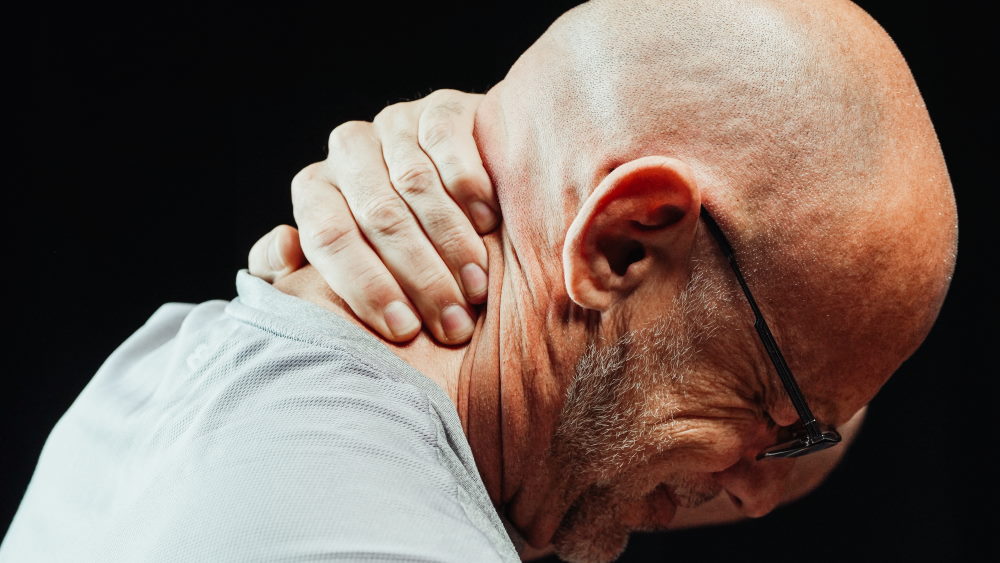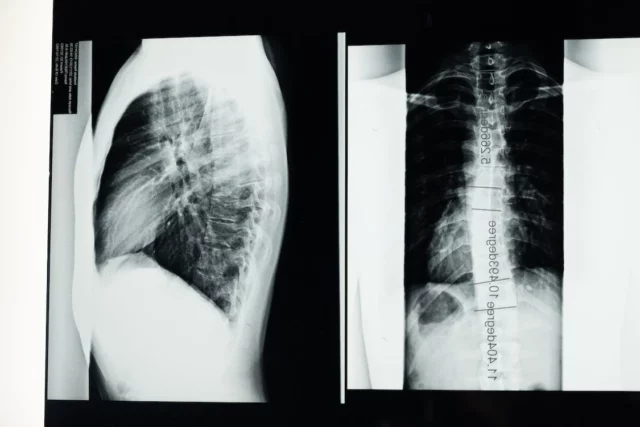A herniated disc in the cervical spine is a common cause of pain and lack of impairment. Cervical herniation affects approximately 2% of the population and is most common in men between the ages of 30 and 50. In many cases, cervical herniation is the result of a specific incident or injury and may be work-related, which means workers’ compensation could become involved.
Here we’ll discuss C5 and C6 disc herniation symptoms, treatments, and how an experienced legal team can help you recover. Before we get to that, though, we first need to understand the inner workings of the spine itself.
How Does the Spine Work?
The spine is a hollow, flexible tube of bone that connects the base of the skull to the top of the pelvis. The spine is made of 33 individual bones, called vertebrae, with a unique shape and function in the body. The hollow center of each vertebra creates a tunnel that protects the spinal cord — a long bundle of nerves that connects the brain with the rest of the body.
Each vertebra is stacked on top of the other, with a cushion of gel-like cartilage between them, called a “disc.” This cushioning between each vertebra helps to keep the spinal column closed, protecting the nerves while still allowing the vertebrae to move and flex during daily activities. This combination of features gives the spine several critical functions in the body:
- Protects the spinal cord, ensuring neural connections between the brain and the body
- Supports the upper body, with each vertebra helping to carry the weight of the upper body and hold us upright
- Allows unencumbered movement, as the padding between vertebrae stretches and compresses to allow us to move, twist, and lift
The spine is made up of several distinct segments, with the cervical vertebrae in the neck, the thoracic vertebrae in the middle back, the lumbar vertebrae in the lower back, and the sacral vertebrae connecting to the hips. This creates a common way of referring to the specific bones in the spine. For example, “C4” is the fourth cervical vertebra, while “L1” is the first lumbar vertebra.
What Is Disc Herniation?
A disc herniation in the spine is when the tough fibers that hold the spinal column together, or the soft gel-like discs, are weakened or injured, allowing some of the nerve tissues in the spinal cord to slip out of place and bulge into the space between the vertebrae. This bulging, or “herniation,” can cause those nerve tissues to be pinched or compressed between the bones of the vertebrae.
These types of injuries vary in severity, causes, and treatments but can be incredibly painful as the nerves are compressed by the bones in the spine.
Common C5 and C6 Disk Herniation Symptoms
Cervical disc herniation causes neck pain, but it is usually characterized as a burning or stinging pain, unlike mechanical neck pain. Some of the most common symptoms of cervical spine disc herniation include:
- Pain in the neck, shoulders, or upper back
- Neck pain that travels to the shoulder, arm, or fingers
- Pain that increases when bending or turning the neck
- Weakness, numbness, or tingling in the arms
Severe cases may also include loss of balance and coordination, problems with fine motor skills, or a shock-like feeling that runs down the entire body. Depending on which disc has herniated, pain may be experienced differently, as different nerve roots are affected. More specifically:
- C5 and C6 disc herniation symptoms. C5 and C6 are the most common areas for disc herniation. Symptoms include weakness in the biceps and front of the upper arms, weakness in the wrist extensor muscles as well as pain, numbness, and tingling that radiate to the thumb side of the hand.
- C4 and C5 disc herniation symptoms. C4 and C5 disc herniation causes weakness in the deltoids and upper arms, along with shoulder pain. This herniation does not usually cause numbness or tingling.
Symptoms of Bulging Disc in Neck C5-C6
Some of the most common symptoms of C5-C6 herniation can be experienced when the structures of the spine are weakened but not ruptured. A weakening in the gel-like outer layer of the spinal disc — called the annulus — extends it outside of its normal position and can allow nerves to shift out of place, becoming compressed between the discs of the spine. This type of injury, where structures are moved out of place but not ruptured, is called a “bulging” or “protruding” disc.
Symptoms of a bulging disc in C5-C6 include:
- Pain and discomfort in the neck and shoulder. Neck pain and discomfort is the most common symptom of a bulging disc. The pain may get worse when the head, shoulder, or arm are moved into certain positions.
- Numbness and tingling. Numbness, tingling, or a feeling of “pins and needles” are also a common symptom of a bulge between C5 and C6. The feeling typically radiates down the arm into the thumb and fingers.
- Decreased range of motion. Pain or stiffness in the neck and shoulder may decrease your range of motion, impairing your ability to fully turn the head and neck.
- Arm and Shoulder Weakness. Weakness in the shoulder, arm, and wrist are common symptoms of a bulging neck disc.
Because a bulging disc may only affect a portion of the disc, some people with bulges or protrusions in the C5-C6 disc experience these symptoms sporadically or inconsistently. Some people may have a bulging disc with few or no symptoms at all.
That said, the symptoms of a disc bulge and a disc herniation are, generally speaking, very similar because they are the result of a similar condition. Whether the disc is fully ruptured or simply shifted out of place, there is a compression of nerves in the neck and spine that causes pain and weakness.
C5-C6 Nerve Root Compression Symptoms
Nerve compression in the neck is called “cervical radiculopathy.” It is caused by nerves in the spine becoming pinched or compressed. The most common symptoms of nerve compression or cervical radiculopathy are:
- Pain. The pain of cervical radiculopathy is usually described as sharp or burning pain. Pain may be caused by moving or bending the neck in certain ways.
- Numbness or tingling. The feeling of numbness or tingling may travel all the way from the neck to the fingers, radiating down the arm.
- Muscle weakness. The nerves in the cervical spine connect to your shoulders, arms, chest, and upper back. Weakness in any of these areas may be a symptom of cervical nerve root compression.
- Weakened reflexes. A weakened reflex in the biceps tendon is a common symptom of C5-C6 nerve compression. Using a reflex hammer on the tendon just above the elbow can indicate cervical radiculopathy.
People with nerve root compression in C5-C6 may experience some or all of these symptoms, and sometimes none of these symptoms. Symptoms are typically asymmetrical, affecting one side of the body more than the other. Many people with cervical radiculopathy experience relief from symptoms when they put their hands on top of their head, taking pressure off of the nerve root.
Cervical radiculopathy affects about 85 out of 100,000 people, and 25% of cases involve the C6 nerve. It is more common as people age, and age is strongly correlated to the cause of nerve pain in the cervical spine.
- Cervical radiculopathy caused by a herniated disc, typically as a result of injury, is most common in adults under 50.
- Cervical radiculopathy caused by a bulging or protruding disc, often as a cause of wear or repetitive motion is most common in adults between 50 to 70 years of age.
- Cervical radiculopathy caused by foraminal narrowing due to arthritis or stenosis, or cervical spondylosis due to degeneration, is most common in adults over 70.
Whatever your age, it is important to seek medical care for neck pain and receive the appropriate treatment. Neck nerve root compression can be extremely painful and inhibit your daily activities and quality of life.
Causes of Spinal Disc Herniation and Injury
Naturally, most disc herniations are caused by age. Over time, the discs in our spine become less flexible and resilient, making them more prone to injury. This is why disc herniation is most common in our 30s, 40s, and 50s. However, unlike mechanical neck pain, most people with a herniated disc can trace their pain to a specific incident or occasion. Some of the most common causes of cervical disc herniation are:
- Sudden, jarring motions can cause disc herniation, but herniation can also be caused by repetitive motion and wear over time
- Many cervical disc herniations are caused during the lifting of heavy objects
- Accidents and injuries. Falls, car accidents, and other types of accidents can cause a herniated disc in the spine
If you suffered a disc herniation or other spinal injury on the job, you may be able to file a workers’ compensation claim.
Typical C5 and C6 Disc Herniation Treatment
The best C5 and C6 disc herniation treatment depends on the degree of injury, but most doctors will attempt to reduce the related inflammation that increases the severity of pain and symptoms. Common C6 herniated disc treatment methods include:
- Anti-inflammatory medications
- Neck brace to stabilize the neck and promote healing
- Physical therapy to reduce pain and restore range of motion
- Exercise and self-care to help patients recover and protect the spine
In some cases, doctors may use injections to deliver medication directly to the affected area. In severe cases, with persistent pain and ongoing impairment to everyday functionality, surgery may be required to repair, remove, or replace the damaged disc.
C5-C6 Nerve Root Compression Symptoms and Treatment
If the symptoms of nerve root compression in the neck are not caused by an injury or disc problem, they are often easy to treat and may resolve on their own in 8 to 12 weeks, with minimal intervention. Most healthcare providers will recommend the following treatments for C5-C6 nerve root compression:
Immobilization
Immobilizing the neck for a short period of time may help to alleviate symptoms and reduce pain from nerve root compression. A healthcare provider may recommend a soft collar or neck brace to reduce movement and support the neck. Generally speaking, these devices should not be used for longer than a week or two, in order to avoid weakening neck muscles.
Medication
The most common medication for the symptoms of nerve root compression is oral NSAID medications such as aspirin, ibuprofen, or naproxen. These medications reduce pain and also help to target and reduce inflammation in the affected area. A healthcare provider may also prescribe oral corticosteroids to further reduce inflammation and pressure on the affected nerve root.
Physical Therapy
Physical therapy can help to reduce nerve pain in the neck and restore strength and range of motion. Every physical therapy regimen is unique, but treatment will typically begin with gentle stretching and range of motion activities, and then work on building strength and improving condition in the neck. If your nerve root compression is due to an occupational injury, physical therapy may also focus on ways to improve your posture and perform work-related tasks safely.
Epidural Steroid Injections
Injections of steroids or corticosteroids into the cervical spine can relieve pain and inflammation in the area. These treatments do not relieve pain caused by disc protrusion or herniation, or by a narrowing foramen, when the nerve root pressure is due to physical compression, but can cause relief when pain is due to inflammation.
Further treatments for cervical nerve root compression typically treat the herniation, bulging, or foramen narrowing caused by other conditions in the neck and spine.
C5-C6 Disc Bulge Treatment
In the case of C5-C6 disc bulging or protrusion, many healthcare providers begin by treating the pain of pressure and inflammation in the neck. Many of the minimally invasive treatments for bulging discs are the same as the treatments for nerve compression above — immobilization and rest, medication for pain and inflammation, and targeted exercises and stretches to improve mobility.
When neck pain is caused by a bulging disc, however, further treatments may be needed. Some of the most common treatments for C5-C6 disc bulges include:
Selective Nerve Root Anesthetic Injections
Injecting an anesthetic directly into the spinal nerve as it exits the foramen can help relieve pain in the area and is often used to identify which specific nerve root is being compressed.
Cervical Traction
In many cases, pain and pressure from bulging discs are relieved by using a traction device. A cervical traction device is strapped to the head and gently lifts upward, stretching the neck and elongating the cervical spine, reducing pressure on the disc.
Transcutaneous Electrical Nerve Stimulation (TENS) Therapy
TENS therapy places small electrodes over the area experiencing pain and then sends a gentle electrical current to the area. It is commonly used in a physical therapy or chiropractic setting to see if it provides relief from pain.
These treatments provide relief from pain and pressure in the neck and spine but do not repair damaged discs. If a disc is truly ruptured/herniated/slipped, surgery is usually needed to repair the injury.
Slipped Disc C5-C6 Treatment
If the above methods do not relieve pain and restore strength and functionality in the neck, surgery is recommended to repair a slipped C5-C6 disc. There are many different surgical options, depending on the specific area of damage, the extent of the damage, and the overall health and condition of the patient.
Generally speaking, the surgery to treat a C5-C6 slipped disc consists of removing the affected disc. A surgeon may add a structure that allows the newly-adjacent vertebrae to fuse together or replace the removed disc with an artificial one. Surgery may be performed from the front or the rear of the neck, depending on the placement of the bulge or herniation.
Surgical repair of a slipped C5-C6 disc is considered a reliable treatment with favorable outcomes. Serious complications are rare, and most patients experience significant relief from pain and weakness due to compression in the cervical spine. However, the recovery period is important, and patients should limit their activities and rest after surgery. The amount of time away from work and other daily activities should be discussed with your surgeon.
How Can Aaron Allison Help?
In the state of Texas, there are time limits to apply for a workers’ compensation or personal injury case. If you are suffering from neck pain, the statute of limitations starts on the date of your injury or from the date when you were made aware that your pain is the result of an injury. For example, if you have persistent neck pain, and a doctor tells you that you have a herniated disc as a result of repetitive strain from work, the statute of limitations begins from the date of this diagnosis — meaning you have a limited time in which to file your claim.
If your disc herniation or neck pain is a result of an accident or injury, you should contact a personal injury attorney right away. A qualified attorney will help you understand your rights, negotiate a settlement, or take your case all the way to court.
The law firm of Aaron Allison has been helping people recover damages from their injuries since 1978, and our family-run office offers expert guidance in personal injury and workers’ compensation cases. Contact us for a free consultation to discuss your case.







